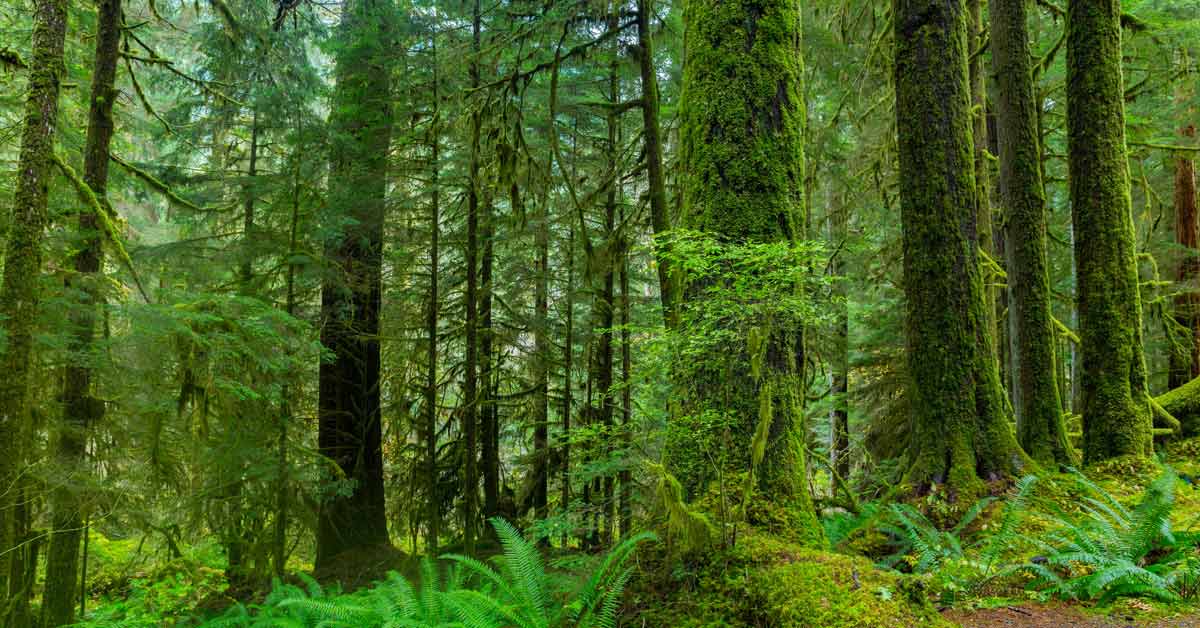6 min read
Old vs. Young Forests: Examining CO2 Storage and Wildfire Risk
 Harvey Greer
:
Jul 21, 2023 12:00:00 AM
Harvey Greer
:
Jul 21, 2023 12:00:00 AM

As the Canadian wildfires rage on, their widespread impact is evident even from hundreds of miles away with smoke enveloping parts of North America. Climate change has led to warmer and drier conditions, increasing the frequency and intensity of wildfires. This, in turn, has resulted in a substantial release of CO2 into the atmosphere.
A striking example is California's 2020 wildfire season, which emitted enough CO2 to set back 20 years of collective efforts toward carbon capture. These fires ranked as the second-largest emissions source in the state, surpassed only by transportation emissions. This underscores the urgent need to address and control wildfires to mitigate their harmful effects.

It’s important to mention that significant work is already being done to mitigate CO2 release through sustainable, low-carbon fuels and precision forest management techniques such as forest thinning and fuel reduction. Yet the reality remains that wildfires will persist, and trees will continue to release carbon.
As we look up at hazy skies and confront this reality, it is crucial to explore additional measures to minimize the environmental and societal impact of these destructive events.
Related: Clearing the Air on Forest Thinning
Related: Putting Forests to Work: How Responsible Forestry Helps Sustainability
Amidst discussions on forest management and wildfire prevention, differing viewpoints exist on the subject. Typically, these include understanding the relationship between forest age, CO2 storage, wildfire risk, and the efficacy of human intervention efforts.
Let’s explore the relationship between these dynamics to shed light on the complex interplay between old-growth and young forests. That way, we can better understand their role in wildfire and climate change mitigation.
How Forest Age Factors into Wildfire Risk
Forest age plays a significant role in wildfire risk, and understanding this relationship is crucial for effective forest management and wildfire prevention. Young and old forests have unique characteristics that can either contribute to or mitigate wildfire risks.
Research published by Ecosphere showed that despite having more vegetation, old-growth forests are less susceptible to high-intensity wildfires than young-growth. The study debunked the assumption that old-growth forests, with their abundant fuel, would be more prone to severe fires and subsequent habitat loss.
Researchers attributed the lower severity of fires in old-growth forests to various factors. Multilayer canopies provide shading, cooler temperatures, moist air and soil, and larger, sturdier trees. These attributes limit the spread of severe wildfires and improve resilience.
Forests that have evolved with a natural fire regime with regular, low-intensity burns often have lower fuel loads. With less to burn, the forests are better adapted to fire and less vulnerable to major fire incidents.
In addition, the relationship between forest age and wildfire risk is further influenced by climate conditions. In warmer and drier regions, both young and old forests face heightened wildfire risks. The combination of high temperatures, low humidity, and strong winds can quickly turn a forest into a tinderbox.
Climate change exacerbates these conditions by creating longer fire seasons and wider burning ranges. Rising temperatures also increase the likelihood of severe wildfires across forest types.
So, what does all this mean for forest management and wildfire prevention efforts? It implies that a comprehensive approach is necessary to best respond to the problem.
A robust plan must consider the age and condition of the forest, local climate conditions, and historical fire regimes. Prescribed burning and forest thinning can be effective strategies for reducing wildfire risks. However, they should be tailored to the specific needs of each ecosystem.
The Truth About Forest Age and CO2

In addition to providing valuable habitats that support biodiversity, old-growth forests—such as the ancient stands in the Amazon rainforest or the giant sequoia trees in California—have also been touted for their high carbon storage capacity.
While it is true that old-growth forests are valuable carbon sinks, recent research from Western Sydney University revealed that young forests are more efficient at capturing and using atmospheric carbon. The study focused on a mature eucalyptus forest, defined as greater than 90 years old, in the Cumberland Plain of Western Sydney. The forest was exposed to higher levels of CO2 than usual.
As Distinguished Professor Belinda Medlyn of the Hawkesbury Institute for the Environment noted, the trees took on the extra carbon. But questions were raised when they later measured total carbon storage amounts.
"Just as we expected, the trees took in about 12% more carbon under the enriched CO2 conditions," she said. “However, the trees did not grow any faster, prompting the question 'where did the carbon go?’"
Further investigation showed that the trees converted the carbon into sugars through photosynthesis. However, those sugars were not feeding into growth within these older trees.
“Instead [of the trees using the carbon], they send the sugars below-ground where they 'feed’ soil microbes [fungi and bacteria],” Professor Medlyn continued.
Part of the reason these trees did not grow was soil composition. The lack of necessary soil nutrients like phosphorous meant the trees couldn’t use that carbon.
Even though the trees absorbed more of it, they inevitably cycled it out and into the soil. From there, microbes used and released that carbon back into the atmosphere.
The study also confirmed that younger forests with good soil quality and sufficient water tend to use increased CO2 more efficiently to promote growth. This suggests that younger trees have a higher potential for carbon storage. However, there is a limit to the maturity of trees and their capacity to store CO2 effectively.
Another important point to note is the speed of carbon absorption. Older trees can store more carbon up to a certain point. But how efficient is this storage process for older and younger trees?
A report by the National Council for Air and Stream Improvement (NCASI) sheds some light on this question:
“Old forests have accumulated more carbon than younger forests; however, young forests grow rapidly, removing much more CO2 each year from the atmosphere than an older forest covering the same area.”
With quality soil conditions, younger forests offer several benefits to achieving carbon absorption goals in standing timber. The best method to maximize these advantages is through a focused forest management strategy.
Strategies for Effective CO2 Management
Addressing the CO2 problem requires a multifaceted approach that balances the need for global lumber production with the conservation of older forests. Maintaining a regular supply of younger trees certainly aids in CO2 removal. But it is essential to avoid indiscriminate logging of mature lumber.
Maximizing carbon storage benefits reflects such a give-and-take between old and new. We must strike a balance between preserving old-growth forests for their ecological value and reducing wildfire risk factors.
Because of the impact of human-caused climate change, relying on natural processes is insufficient at this point. Proactive human interventions are necessary to mitigate the imminent threats these forests face.
Here are several key actions to consider:
1. Carbon Capture and Storage

Carbon capture and storage (CCS) technologies play a critical role in reducing carbon emissions and combatting climate change. Super-efficient energy production facilities can capture and conserve considerable carbon from the burning of fuels. In addition, managed forests and the implementation of global biofuel mandates have shown promise in employing CCS methods.
But what about removing CO2 from the atmosphere after it is released? The bioenergy industry sort of accomplishes this task with a process known as bioenergy with carbon capture and storage (BECCS). Biomass from sources like wood can remove CO2 from the air through photosynthesis. After the absorption, these fuels are then burned to produce energy, and the released carbon is conserved using more traditional CCS technologies.
These interventions are extremely important, but they do not fully accomplish the goal of removing CO2 that’s already in the atmosphere. Currently, the best method to achieve this is known as direct air capture (DAC). DAC involves a chemical process to remove carbon from the air itself. But the problem with this method is its inefficiency in absorbing atmospheric carbon.
It’s one thing to use DAC on an active smokestack billowing out much higher concentrations of CO2. It’s a much different challenge in the normal atmosphere as DAC yields far less carbon—and at much greater expense. This option is not quite there yet for widespread adoption as the cost-benefit ratio and use of chemicals to achieve such a broad goal are simply too high right now.
2. Better Accounting for Wildfires in Climate Policy
The risk of carbon release from wildfires is projected to rise in the coming years. This reality needs to be more directly acknowledged within country- and state-wide regulations and considerations. That's why directly addressing wildfires within climate policy is crucial.
By incorporating wildfires within climate policy, we can better account for the emissions they have produced and will cause in the future. It will also bring increased attention to better address and mitigate their damage while helping to reduce the risk of widespread devastation.
3. Targeted Forest Management Initiatives

Finally, streamlined forest management directly incorporating wildfire mitigation remains fundamental to combating the issue. Forest management involves a concentrated approach to planning and responding to the increased risks from fires. These include immediate actions such as forest thinning, fuel reduction, and prescribed fires and long-term changes such as more fire-resistant stands and growing practices.
Cooperation is Key to Enacting Real Change in Wildfire Response

As these examples show, we need to develop cooperative solutions to meet the immense challenges posed by wildfires. The range, extent, and severity of climate events like fires are not going anywhere. Accordingly, we must identify and adopt policies and strategies to get the most from these trees before they’re lost.
Working together to develop better technology for atmospheric carbon capture is essential. Likewise, enacting policies that account for the damage and provide support to prevention and response efforts. All these interventions must be underpinned by effective forest management strategies and mitigation efforts.
The only way we can move these goals forward is through an interconnected, global effort of cooperation and focus. There is no plan B for achieving emissions goals and stopping the catastrophic, irreversible effects of climate change. Without a cooperative approach, we’ll all end up finding ourselves lost in the smoke.
ResourceWise provides targeted business intelligence products across the forest value chain.
Angela Rockwell also contributed to this post.





